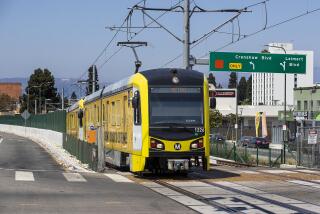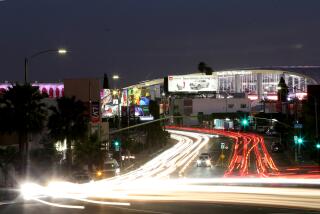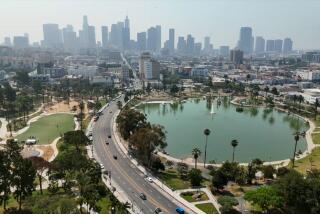Electric Bus Route Draws Opposition : Transportation: Influential area improvement association calls overhead wires unsightly and opposes the trimming of trees that line Los Feliz Boulevard. The trolley bus line would link Glendale to Hollywood.
LOS FELIZ — Residents along and near Los Feliz Boulevard say a proposed electric trolley bus would disfigure the boulevard’s 75-year-old deodar trees and increase traffic in the historic neighborhood.
The proposed route, which would link Glendale to Hollywood via Los Feliz, is one of 12 to be included in the first phase of a countywide electric trolley bus network. The Southern California Rapid Transit District is developing the routes in conjunction with the Los Angeles County Transportation Commission in an attempt to reduce its fleet’s pollution levels.
The board of the influential Los Feliz Improvement Assn. voted last week to oppose the installation of overhead wires along Los Feliz Boulevard and any trimming of the deodar trees along the route.
“I really do not want those buses on Los Feliz Boulevard,” said board member Marisa Antonini, who lives on Los Feliz. She said the current traffic problem is already enormous.
But despite the vote, “we basically support the concept of the electric trolley bus,” board member Donna Matson said.
But Albert H. Perdon, RTD transit systems development director, said the electric trolley bus will reduce traffic by increasing the use of public transportation.
The electric trolley buses will replace diesel bus Routes 180 and 181, which currently travel along Los Feliz and link Pasadena, Glendale and Hollywood. Those routes, which have 17,300 daily boardings, are among the busiest in the bus system, Perdon said. In addition, the new electric route will include Burbank.
Electric trolley buses resemble diesel buses but are run by electric motors powered by overhead wires. These wires are connected to the top of the bus by poles.
Improvement association members were also concerned that the branches of the deodar trees that line Los Feliz would have to be cut to make room for overhead wires used to power the trolleys.
But Perdon said a recent RTD survey estimated that only about 22 of the 162 deodar trees along the route would need minor trimming. Branches greater than three inches in diameter would not be affected, he said.
The Tri-City Transportation Coalition, which works to increase the availability of transportation along the east-west corridor linking Pasadena, Glendale and Burbank, has lobbied for the inclusion of the route in the first phase of the RTD plan.
That has caused some Los Feliz residents to charge that RTD is ignoring their interests. RTD is “enhancing things for people in other cities with reckless disregard for (how) they are impacting the community they are tramping through,” association board member Marilyn Bush said.
The bus plan comes in response to the South Coast Air Quality Management District’s demand that RTD convert 30% of its bus fleet to electricity by the year 2010. RTD operates about 2,500 buses.
In addition to being less toxic, electric trolley buses are quieter and faster than diesel buses, RTD officials say. They currently operate in San Francisco and in Vancouver, Canada.
In Vancouver, planners have been able to disguise wires by painting them green, said James Okazaki, chief of transit programs at the Los Angeles Department of Transportation.
The route also requires the construction of poles to support the overhead wires, but planners are looking into using some existing street-light poles.
RTD has budgeted $500,000 per mile for landscaping that will serve to downplay the wires and poles. The cost of the 12 routes is estimated at from $1 billion to $1.2 billion, Perdon said.
A draft of an environmental impact report on the project is due at the end of October. After that, RTD plans a series of workshops to get community input about the project.
More to Read
Sign up for Essential California
The most important California stories and recommendations in your inbox every morning.
You may occasionally receive promotional content from the Los Angeles Times.










